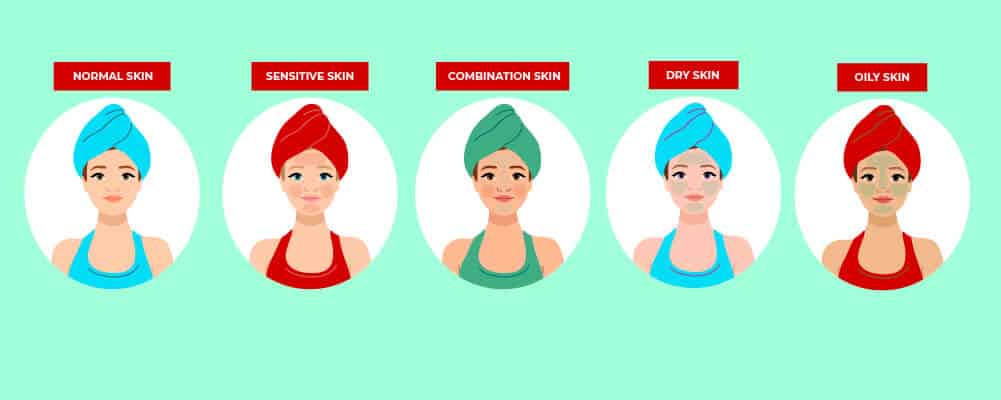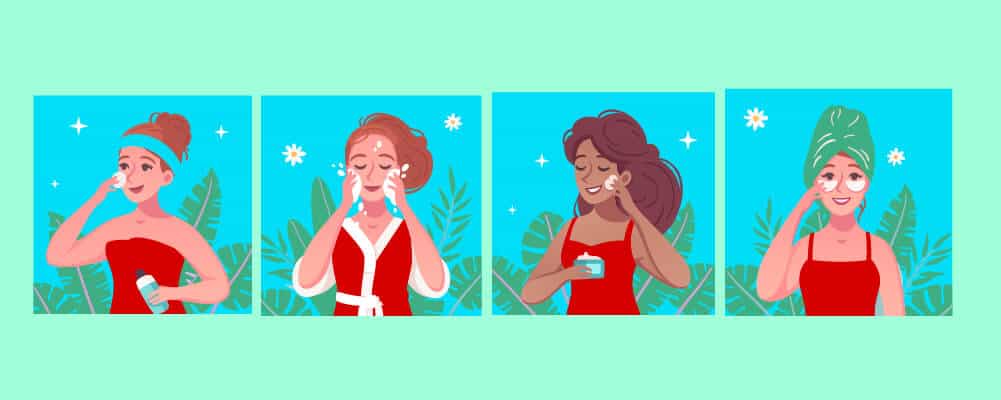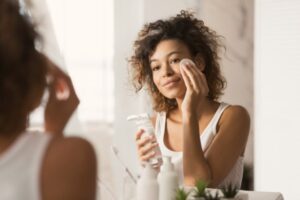Your skin is the first thing that people see when they look at you, so it’s pretty important that it’s healthy! Of course, there’s so much information out there about achieving a healthy complexion that it can often be difficult to know where to start. Do you need to buy a million products? Are there certain foods that you need to avoid? What gives?
Today we’re here to give you the lowdown on everything that you need to know about healthy skin, from some of the skin products out there to what sorts of foods are best to eat for healthy skin. By the end of this article, you too will have a healthy and glowing complexion and so much more self-confidence!
Skin 101

Okay, so what do you need to know about the largest organ in your body? It turns out that your skin is a lot more complicated than people would have you believe. It supports all of the organs inside of your body, and your skin can actually be an accurate reflection of the different processes going on inside of your body. The first thing to know is the different layers of the skin.
Epidermis
First on the list is the Epidermis. This is the very first layer of your skin and it’s the one that everyone is looking at when their eyes are on you. In that sense, the Epidermis really hogs the limelight! The epidermis is pretty cool since it also has five sublayers which are great in the event that you manage to injure yourself.
As time passes and different things happen, the skin from the epidermis starts to shed and the skin regenerates. Then you have all new skin cells that help to protect you. The epidermis also creates melanin which is responsible for the tone of your skin. It stops pathogens and germs from getting into the skin too since it creates a waterproof barrier to stop things from getting in.
Another thing that is present in the epidermis is your pores. Your pores are important since they let oil and sweat escape, but if you have too much oil on your skin you may find yourself with acne later down the line. A lot of medical conditions can start on the epidermis, such as boils, atopic dermatitis, and the big kicker especially if your hormones are out of whack – acne. It may seem obvious to say, but it’s pretty important that you look after your epidermis if you want that lovely, glowing skin.
Dermis
When you’ve gotten through all of those layers of the epidermis, you then get to the dermis. This is super thick and it’s where your oil, sweat, lymph vessel, nerve endings, and connective tissues all hang out. It helps to protect your body from pathogens in a bigger way than the epidermis, in many respects. It helps to support your epidermis.
Like with the epidermis, there are also skin conditions that can start in the dermis, such as sebaceous cysts, dermatofibroma, and cellulitis.
Hypodermis
Finally, once you’ve dug past all of that skin, you make it to the last layer. The hypodermis. This layer of skin is a much deeper kind of tissue, and it consists of big blood vessels, connective tissues, and fat. This part of your skin is pretty important despite the fact that you can’t see it because it helps to keep your body temperature regulated. It helps to ensure that you don’t lose body heat when it’s cold outside.
This layer of the skin is occasionally referred to as the subcutis layer. It also helps to protect your organs – it’s basically there for shock absorption in case you get hurt.
Skin Types

Did you really think that your skin would be as simple as 3 layers? Nope – we’re all individuals. As such, there are a number of different types of skin, and your personal skincare should be partially based on your skin type. There are a few different skin types to note, so stick with us!
Normal Skin
The first skin type is normal skin. As the name suggests, it’s a middle ground between oily and dry skin. Not too oily, not too dry. The texture is pretty normal, and you generally won’t get many problems with it. There aren’t really any special care routines that you need to do to get the best out of your normal skin, but they can always help!
Oily Skin
Oily skin is what many people consider to be the problem child of all skin types, but there are a lot of benefits to having oily skin! This skin type is characterized by its bright appearance and you can usually see your pores quite easily. Usually, oily skin means that the sebaceous glands in your skin are working on overdrive, generally as a result of your hormones or a genetic predisposition. This skin type is most common in people under the age of 30 and in teenagers. It tends to bring with it a more likely chance of acne.
Dry Skin
One of the most common skin ailments is dry skin. Dry skin tends to be impacted by external factors like the weather, humidity, soap products, and diet. Sometimes dry skin can be a temporary thing, but this is not always the case. Dry skin may occur thanks to your age, health, or various other causes. You may feel that the skin feels tight and looks a little ashy gray.
One of the most frequent causes of dry skin is taking hot showers. While hot showers feel great, hot water dries out the skin and opens the pores. Dry skin can cause cracking and if left untreated can become quite painful. Additionally, the heat opens up your pores, which allows bacteria to grow and frequently results in an acne breakout. If you like hot showers, try turning the heat down and splashing cold water on your face as soon as you get out of the shower in order to close up your pores. Additionally, using moisturizer as soon as you get out of the shower is a great way to keep your skin healthy and hydrated.
Combination Skin
This is basically what it sounds like. Combination skin combines one or more different types of skin. For instance, you may get more oil on the T zone – the area around your chin, nose, and forehead – and the skin on your cheeks may be dry or normal instead. There are usually products designed specifically to handle combination skin.
Sensitive Skin
If you have sensitive skin, then it usually means that you are more likely to react to external stimuli in a negative way. This is in contrast to normal skin that may not have a problem with external stimuli. When you have sensitive skin, you may notice that you feel uncomfortable when your skin comes into contact with certain things. You may notice symptoms such as overheated skin, redness, or tightness on the epidermis.
Many people go months or even years believing sensitive skin is something they just have to live with. However, skin sensitivities will typically see a vast improvement if you remove the external stimuli causing skin issues. If you have sensitive, delicate skin you will need to pay special attention to the soaps, moisturizers, clothing, and bedding you use. Many soaps and moisturizers have harsh chemicals that cause dry skin and peeling for people with sensitive skin. Try looking for paraben-free soaps directly targeted towards people with sensitive skin. Additionally, pay special attention to the type of pillowcases you use and how often you wash them. Cotton pillowcases collect dirt and oil which rub against your face at night. At a minimum, you should be washing your pillowcases 1-2 times per week. If this does not help buy satin or silk pillowcases. Satin and Silk are much easier on your skin and do not collect as much facial oil as a cotton pillowcase.
Acne Prone Skin
Acne-prone skin is essentially more likely to develop acne. This could be for a variety of reasons. For instance, it may occur if you are a teenager or you are pregnant and your hormones are going wild. It can also happen in conditions such as Poly-Cystic Ovarian Syndrome in women where the skin produces excess androgens.
Hormones aren’t the only cause, of course. Sometimes acne is more likely to occur in people that have skin that is naturally oily. If acne is getting out of control, it can often help to speak to a dermatologist for further advice and treatment.
Mature Skin
As you age, your skin can go through a lot of changes. It can change a lot especially as you get older. Mature skin is characterized by a number of features, such as the appearance of fine lines, skin hydration issues, loss of elasticity and a more common occurrence of skin irritation. This can happen for a variety of reasons, but there are thankfully many ways that you can look after your mature skin.
Basics for Healthy Skin

Now that you know the basics about how your skin functions, what do you need to do in order to care for this massive organ? Here are some of the basics of keeping your skin healthy.
Use SPF Everyday
First up, make sure that you are slathering your skin in all of the sunscreen that it needs. UV light can cause all sorts of problems, including skin cancer, wrinkles and blemishes, among other things.
If you wear your sunscreen then you can minimize the amount of damage that you get from the sun. It can help you to ensure that your skin remains healthy and clear.
Specifically, you should be looking for a sunscreen that will protect you against both UVA and UVB rays. It should also be SPF 30 at the minimum to ensure that your skin has the coverage that it needs.
If you have a skin condition such as vitiligo then you may wish to go with a higher sunscreen – your dermatologist may be able to recommend one to you. In addition to this, make sure that you’re careful about the type of sunscreen you use if you are going in the ocean. Some kinds of makeup also come with SPF protection built into them, so you should definitely look out for that.
Moisturizing
It’s also important to ensure that you moisturize your skin too. Moisturizers are important as they will hold water on the epidermis. It helps to keep your skin hydrated, minimizing the risks of getting dry or dead skin.
You may be thinking that it’s a bad idea to use moisturizer if you have oily skin. Surprisingly, this is not the case. It’s actually quite important that oily skin is moisturized, since you will likely use some abrasive products when you are washing oily skin. As such your skin is going to need moisturizing to protect it from getting damaged.
Make sure that you are buying the right kind of moisturizer for your skin type too. For instance, if your skin is dry and cracked, it may be better to get ointments such as vaseline. For normal skin, a water-based moisturizer will likely be best for you. If you have acne-prone skin Cerave has multiple moisturizers that can hydrate your skin without clogging your pores. No matter what type of skin condition you have it’s worth looking into different products that you can use.
Avoid Smoking
Smoking can have a massive effect on your skin. For starters, there are toxins in cigarettes and these can result in aging prematurely, cancer, and all sorts of other problems. It can also mean that your body doesn’t heal wounds as well. Other problems that can crop up include acne inversa, vasculitis, and more.
All hope is not lost if your skin has been affected by smoking, however. Most people find that a lot of their health worries clear up when they stop smoking. Of course, it’s not always easy to quit smoking. If you are struggling to stop smoking, then it’s worth getting some help.
It is important to be aware that withdrawal symptoms from smoking cigarettes can cause nausea, irritability, insomnia, and even acne. These side effects are all a normal part of the body’s detoxification process and although they are painful to go through your body will thank you in the long run. In the first three to four weeks after you quit smoking do not be surprised if you have dry skin or acne breakouts. This should subside in a few weeks and will lead to stronger, healthier skin long-term.
Drink Lots of Water
Moisturizer isn’t the only way that you can keep your skin well hydrated. It’s also important to ensure that you nourish your body with plenty of water too. It’s even more important when your skin is out in the sun. Make sure that you are drinking lots of water and eating foods with a high water intake – strawberries, watermelon, and cucumbers are a good idea.
Although most people believe they have adequate daily water intake a staggering 75% of Americans suffer from chronic dehydration. In order to have proper hydration, you should divide your weight by “2” and drink that number of ounces every day. So if you weigh 150 pounds you should be drinking at least 75 ounces of water per day. If you exercise or take supplements you will probably need to drink more water to stay properly hydrated.
Additionally, try not to drink too much alcohol. While it is a fluid, alcohol is known for naturally dehydrating the skin, which is the last thing that you need if you are trying to improve your complexion. Drinking water is important for all of the other organs in your body too, not just your skin.
Eating Your Way to Glowing Skin

What you eat can have a huge impact on how your skin looks and feels. Not only that, but eating well also helps you to feel much better in yourself in general. So how do you eat for glowing skin? There are a few obvious things, like eating healthy, but here’s a breakdown.
Antioxidant-rich Foods
If you want to have healthy, glowing skin, it’s always a good idea to make sure that you eat plenty of foods full of antioxidants. Antioxidants are important as they reduce the amount of free radicals produced by the body, which can hurt your skin in the long run. If you eat antioxidants, then you can keep your skin hydrated and help your skin to maintain its moisture. If your skin looks dull, antioxidants can help bring it some new life.
Antioxidants have a number of roles in your skin. For starters, antioxidants are great as they make it easier for your skin to repair itself. This is because it can reduce the inflammation on the skin. It also is great for preventing damage from the sun.
So what are the antioxidants that you should be taking? Foods like blueberries are a good choice, as are sweet potatoes. You can also take turmeric, which is especially good for getting rid of extra oil on the skin which can sometimes result in pimples for people. Try to eat dark leafy greens and avocados too. If you are struggling with getting enough antioxidants into your diet, you can also take supplements that may help. They’re usually quite affordable in the grocery store, or you can get a multivitamin.
Avoid Alcohol
Alcohol is a big no-no if you are looking to improve your skin quality. This is because alcohol is known for its dehydrating qualities – that’s the last thing that you need if you want to have vibrant, healthy skin. That’s not the only thing either. Alcohol can sometimes mean that your face will end up looking puffy and bloated. It can result in reduced elasticity, meaning that your skin will be more prone to wrinkles and sagging, making it dry out.
Of course, it doesn’t mean that you need to completely cut alcohol out of your life – it’s okay to have a drink every once in a while. It’s just best to reduce the amount of alcohol that you drink on a regular basis. Additionally, consuming alcoholic beverages with low sugar such as tequila, gin, and vodka are much better for your skin than sugary beverages like margaritas or beer. The important thing is to make sure that you have a couple of days each week where you are not consuming any alcohol. The less alcohol you drink the healthier skin you will have.
Skin Friendly Foods
So you know all about the benefits of antioxidant foods for the skin, but what other foods should you be eating to enrich your skin?
For starters, eating lots of healthy, fatty fish is always a good place to start. This is because they are full of omega 3 fatty acids, and these play a big role in keeping your skin healthy and well moisturized. If you have a deficiency in omega 3 fatty acids, you may end up having dry skin too. You can also try avocados which contain healthy fats that are important for ensuring that your skin maintains its elasticity.
Some other good choices include walnuts, and sunflower seeds. In reality, it’s good to have a lot of nuts and seeds in your diet anyway since they contain a lot of the nutrients and vitamins that are pivotal for good skin health. Broccoli is another good choice, as are sweet potatoes and green tea. Even a little bit of dark chocolate every once in a while can be good for your skin health!
What to Avoid
As you probably expected, there are also some foods that are best to be avoided if you want to have gorgeous, glowing skin. One example of this is refined sugar. Sugar has inflammatory properties, and this can often mean that problems such as eczema, acne, rosacea and psoriasis are made significantly worse. Try to stay away from other foods such as white bread, fruit juices and cereals that are full of sugar.
It’s also a good idea to stay away from any foods that contain pesticides. Foods that contain dairy should be minimized too, since they can contain hormones that can cause problems for your skin. Likewise, you should try to minimize things like takeout and heavily processed foods. This will be good not only for your skin, but also for your general health and wellbeing. Ideally, you just want to try and eat a healthy diet filled with antioxidants, fruits and vegetables and lean protein. There’s plenty of advice online to lead you in the right direction if you aren’t sure about where to start.
Exercise for Flawless Skin

This is something that you may not have expected to be on this list! As it turns out though, exercise can have a monumental effect on your skin. If you want t o have better skin and generally feel better in yourself, then exercise combined with a healthy diet are essential.
You can feel the positive effects of exercise immediately after a workout in many cases. This is because exercise brings more blood flow to your skin and the lymph flow increases, and this will start off by reducing the puffiness around your eyes. You will notice that post workout glow after you exercise – it’s a real thing!
Of course, it’s always important to note that exercise can have some negative effects on the skin if you don’t properly take care of your skin after a workout. Namely, dirt can build up on your skin after a workout if you don’t wash your face, and this can result in conditions like eczema and acne getting worse. This is usually easily mitigated by having a good post workout skincare routine.
Exercise is especially good for your skin during the aging process. It helps to increase the number of mitochondria in your cells, and this can help the cells to behave a little more like they did when they were younger. This can result in better skin, muscles and more.Naturally, these are just a few of the benefits worth considering.
Indirect Effect by Bettering Sleep
Another thing worth noting is that exercise can affect your skin because of the effect on your sleep. Working out can be pretty tiring, and this can mean that getting to sleep afterwards is a dream. The average adult should be sleeping for around seven to nine hours every night. Being well rested can have a number of different benefits for your skin. Namely, when you are sleeping the blood flow in your skin starts to increase. This means that any damage from UV exposure is rebuilt and the collagen builds back up. This has some great benefits, including reducing the number of age spots on your skin and reducing wrinkles. If you exercise then you will likely sleep better, resulting in a gorgeous complexion.
Lowers Stress
Another one of the key benefits of exercise is that it reduces your stress levels. Your body releases endorphins after you have had a good workout, and endorphins are also known as feel good hormones. The endorphins are important as they can affect your skin cells. If you are stressed then you aren’t getting as many endorphins, and this can sometimes result in problems like breakouts and poor quality skin. It’s especially problematic if you are experiencing chronic stress.
To feel the benefits of exercise on your skin, you don’t need to be spending hours on a treadmill. You should usually be trying to get a minimum of 30 minutes of physical activity each day. This can be any kind of physical activity that you like, including yoga, walking, dancing, lifting weights and more. With time, you can expect to feel better physically and mentally, and you will likely find that there are some improvements in your skin too.
Building a Skin Care Routine

If you want to have glowing, healthy skin, then it’s very important that you build a skin care routine to help you to get the results that you are looking for. Putting a tiny bit of water on your face and then calling it a day isn’t going to cut it. Instead, you should ensure that you find a skin care routine that will fit with your unique skin care requirements. Everyone’s skin is different after all, and what may work for one person may not work so well for another person. With that being said, it’s possible to make some predictions about the routine that may work best for you based on your skin type. Here are just a few ideas.
Acne Prone Skin
Acne prone skin can be especially problematic, even more so if you aren’t sure what the root cause of your acne is. Fortunately, you can create a great skincare routine for acne-prone skin as long as you have the right products. The first thing that you should be doing is ensuring that you cleanse the skin thoroughly in gentle motions. You should do this using either the fingertips of a washcloth. Make sure that you wash the neck, jawline and around the ears too. Get a cleanser that will work for your skin – usually products that contain salicylic acid or benzoyl peroxide are best if you experience acne. If you have particularly sensitive skin make sure to use a gentle cleanser that will exfoliate your skin without aggravating it.
The next thing to do is to find a toner that will work for you and apply it after washing. You could also use an astringent instead. Then you can apply any acne treatments or medications that you have, and finally apply a gel or moisturizer to the face to keep it well hydrated. Remember to put on your SPF too!
Dry Skin
Firstly, you should always speak to your doctor if you have an underlying health condition that may be causing your dry skin, as a doctor will be able to give you an indication about what routine will be the best for you. There are a number of external factors that can also influence dry skin too, such as the weather, humidity and deficiency in B vitamins.
Like with acne-prone skin, it’s best to follow a set routine when it comes to treating dry skin. First of all you should be starting with a cleanser and gently washing the face. For dry skin, a cleanser that contains hyaluronic acid will be good for hydrating the skin. Stay away from any harsh ingredients that will dry out the skin. You should then move onto toning the skin using an alcohol-free toner, and targeting any particular concerns that you may have using a serum. The next thing to do is to apply a moisturizer to the skin – look for something that’s hydrating and non-comedogenic as this will help to keep the hydration in your skin. Finally, apply sunscreen to protect your skin from those harmful UV rays.
Combination Skin
Creating a combination skincare routine can be quite the challenge, since you have more than one skin type. You may need to experiment with different products and methods. Make sure that you’re using gentle products on the skin that will moisturize any dry areas – you don’t want anything that will cause excessive oiliness either. Make sure that you’re only applying treatments to the necessary areas too.
The routine is similar to those mentioned above – cleanse, tone, add a serum, add some moisturizer, sunscreen and then apply any makeup if you wish. Playing around with products will help you to figure out what works best for your skin. For further guidance, it’s worth speaking with a dermatologist who can point you in the right direction.
Summary

Making your skin look healthy and youthful can sometimes be a challenge, but it is by no means impossible! Simply make sure that you are nourishing your skin with the right products and leading a healthy lifestyle, and you are sure to see great results in no time. We hope that this guide will help you to get the results that you are looking for.

